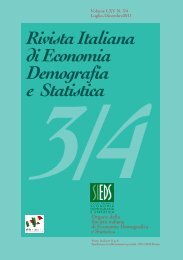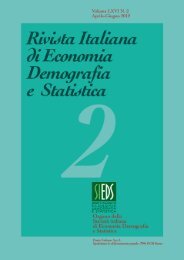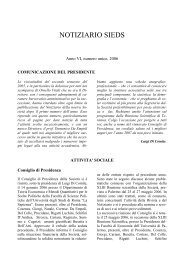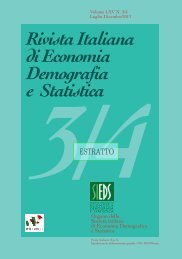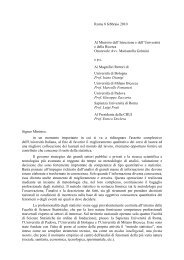- Page 1 and 2:
VOLUME LXIII - NN. 3-4 LUGLIO-DICEM
- Page 3 and 4:
IN QUESTO NUMERO Questo volume acco
- Page 5:
Elena Pirani, Silvana Salvini, Cond
- Page 8 and 9:
8 Volume LXIII nn. 3-4 - Luglio-Dic
- Page 10 and 11:
10 Volume LXIII nn. 3-4 - Luglio-Di
- Page 12 and 13:
12 Volume LXIII nn. 3-4 - Luglio-Di
- Page 14 and 15:
14 Volume LXIII nn. 3-4 - Luglio-Di
- Page 16 and 17:
16 Volume LXIII nn. 3-4 - Luglio-Di
- Page 18 and 19:
18 Volume LXIII nn. 3-4 - Luglio-Di
- Page 20 and 21:
20 Volume LXIII nn. 3-4 - Luglio-Di
- Page 22 and 23:
22 Volume LXIII nn. 3-4 - Luglio-Di
- Page 24 and 25:
24 Volume LXIII nn. 3-4 - Luglio-Di
- Page 26 and 27:
26 Volume LXIII nn. 3-4 - Luglio-Di
- Page 28 and 29:
28 Volume LXIII nn. 3-4 - Luglio-Di
- Page 30 and 31:
30 Volume LXIII nn. 3-4 - Luglio-Di
- Page 32 and 33:
32 Volume LXIII nn. 3-4 - Luglio-Di
- Page 34 and 35:
34 Volume LXIII nn. 3-4 - Luglio-Di
- Page 36 and 37:
36 Volume LXIII nn. 3-4 - Luglio-Di
- Page 38 and 39:
38 Volume LXIII nn. 3-4 - Luglio-Di
- Page 40 and 41:
40 Volume LXIII nn. 3-4 - Luglio-Di
- Page 42 and 43:
42 Volume LXIII nn. 3-4 - Luglio-Di
- Page 44 and 45:
44 Volume LXIII nn. 3-4 - Luglio-Di
- Page 46 and 47:
46 Volume LXIII nn. 3-4 - Luglio-Di
- Page 48 and 49:
48 Volume LXIII nn. 3-4 - Luglio-Di
- Page 50 and 51:
50 Volume LXIII nn. 3-4 - Luglio-Di
- Page 52 and 53:
52 Volume LXIII nn. 3-4 - Luglio-Di
- Page 54 and 55:
54 Volume LXIII nn. 3-4 - Luglio-Di
- Page 56 and 57:
56 Volume LXIII nn. 3-4 - Luglio-Di
- Page 58 and 59:
58 Volume LXIII nn. 3-4 - Luglio-Di
- Page 60 and 61:
60 Volume LXIII nn. 3-4 - Luglio-Di
- Page 62 and 63:
62 Volume LXIII nn. 3-4 - Luglio-Di
- Page 64 and 65:
64 Volume LXIII nn. 3-4 - Luglio-Di
- Page 66 and 67:
66 Volume LXIII nn. 3-4 - Luglio-Di
- Page 68 and 69:
68 Volume LXIII nn. 3-4 - Luglio-Di
- Page 70 and 71:
70 Volume LXIII nn. 3-4 - Luglio-Di
- Page 72 and 73:
72 Volume LXIII nn. 3-4 - Luglio-Di
- Page 74 and 75:
74 Volume LXIII nn. 3-4 - Luglio-Di
- Page 76 and 77:
76 Volume LXIII nn. 3-4 - Luglio-Di
- Page 78 and 79:
78 Volume LXIII nn. 3-4 - Luglio-Di
- Page 80 and 81:
80 Volume LXIII nn. 3-4 - Luglio-Di
- Page 82 and 83:
82 Volume LXIII nn. 3-4 - Luglio-Di
- Page 84 and 85:
84 Volume LXIII nn. 3-4 - Luglio-Di
- Page 86 and 87:
86 Volume LXIII nn. 3-4 - Luglio-Di
- Page 88 and 89:
88 Volume LXIII nn. 3-4 - Luglio-Di
- Page 90 and 91:
90 Volume LXIII nn. 3-4 - Luglio-Di
- Page 92 and 93:
92 Volume LXIII nn. 3-4 - Luglio-Di
- Page 94 and 95:
94 Volume LXIII nn. 3-4 - Luglio-Di
- Page 97 and 98:
Rivista Italiana di Economia Demogr
- Page 99 and 100:
Rivista Italiana di Economia Demogr
- Page 101 and 102:
Rivista Italiana di Economia Demogr
- Page 103 and 104:
Rivista Italiana di Economia Demogr
- Page 105 and 106:
Rivista Italiana di Economia Demogr
- Page 107 and 108:
Rivista Italiana di Economia Demogr
- Page 109 and 110:
Rivista Italiana di Economia Demogr
- Page 111 and 112:
Rivista Italiana di Economia Demogr
- Page 113 and 114:
Rivista Italiana di Economia Demogr
- Page 115 and 116:
Rivista Italiana di Economia Demogr
- Page 117 and 118:
Rivista Italiana di Economia Demogr
- Page 119 and 120:
Rivista Italiana di Economia Demogr
- Page 121 and 122:
Rivista Italiana di Economia Demogr
- Page 123 and 124:
Rivista Italiana di Economia Demogr
- Page 125 and 126:
Rivista Italiana di Economia Demogr
- Page 127 and 128:
Rivista Italiana di Economia Demogr
- Page 129 and 130:
Rivista Italiana di Economia Demogr
- Page 131 and 132:
Rivista Italiana di Economia Demogr
- Page 133 and 134:
Rivista Italiana di Economia Demogr
- Page 135 and 136:
Rivista Italiana di Economia Demogr
- Page 137 and 138:
Rivista Italiana di Economia Demogr
- Page 139 and 140:
Rivista Italiana di Economia Demogr
- Page 141 and 142:
Rivista Italiana di Economia Demogr
- Page 143 and 144:
Rivista Italiana di Economia Demogr
- Page 145:
Rivista Italiana di Economia Demogr
- Page 148 and 149:
148 Volume LXIII nn. 3-4 - Luglio-D
- Page 150 and 151:
150 Volume LXIII nn. 3-4 - Luglio-D
- Page 152 and 153:
152 Volume LXIII nn. 3-4 - Luglio-D
- Page 154 and 155:
154 Volume LXIII nn. 3-4 - Luglio-D
- Page 156 and 157:
156 Volume LXIII nn. 3-4 - Luglio-D
- Page 158 and 159:
158 Volume LXIII nn. 3-4 - Luglio-D
- Page 160 and 161:
160 Volume LXIII nn. 3-4 - Luglio-D
- Page 162 and 163:
162 Volume LXIII nn. 3-4 - Luglio-D
- Page 164 and 165: 164 Volume LXIII nn. 3-4 - Luglio-D
- Page 166 and 167: 166 Volume LXIII nn. 3-4 - Luglio-D
- Page 168 and 169: 168 Volume LXIII nn. 3-4 - Luglio-D
- Page 170 and 171: 170 Volume LXIII nn. 3-4 - Luglio-D
- Page 172 and 173: 172 Volume LXIII nn. 3-4 - Luglio-D
- Page 174 and 175: 174 Volume LXIII nn. 3-4 - Luglio-D
- Page 176 and 177: 176 Volume LXIII nn. 3-4 - Luglio-D
- Page 178 and 179: 178 Volume LXIII nn. 3-4 - Luglio-D
- Page 180 and 181: 180 Volume LXIII nn. 3-4 - Luglio-D
- Page 182 and 183: 182 Volume LXIII nn. 3-4 - Luglio-D
- Page 184 and 185: 184 Volume LXIII nn. 3-4 - Luglio-D
- Page 186 and 187: 186 Volume LXIII nn. 3-4 - Luglio-D
- Page 188 and 189: 188 Volume LXIII nn. 3-4 - Luglio-D
- Page 190 and 191: 190 Volume LXIII nn. 3-4 - Luglio-D
- Page 192 and 193: 192 Volume LXIII nn. 3-4 - Luglio-D
- Page 194 and 195: 194 Volume LXIII nn. 3-4 - Luglio-D
- Page 196 and 197: 196 Volume LXIII nn. 3-4 - Luglio-D
- Page 198 and 199: 198 Volume LXIII nn. 3-4 - Luglio-D
- Page 200 and 201: 200 Volume LXIII nn. 3-4 - Luglio-D
- Page 202 and 203: 202 Volume LXIII nn. 3-4 - Luglio-D
- Page 204 and 205: 204 Volume LXIII nn. 3-4 - Luglio-D
- Page 206 and 207: 206 Volume LXIII nn. 3-4 - Luglio-D
- Page 208 and 209: 208 Volume LXIII nn. 3-4 - Luglio-D
- Page 210 and 211: 210 Volume LXIII nn. 3-4 - Luglio-D
- Page 212 and 213: 212 Volume LXIII nn. 3-4 - Luglio-D
- Page 216 and 217: 216 Volume LXIII nn. 3-4 - Luglio-D
- Page 218 and 219: 218 Volume LXIII nn. 3-4 - Luglio-D
- Page 220 and 221: INFORMAZIONI PER GLI AUTORI REGOLE
- Page 222 and 223: Trivellato U. 1990. Modelli di comp
- Page 224: SOCIETÀ E RIVISTA ADERENTI AL SIST



